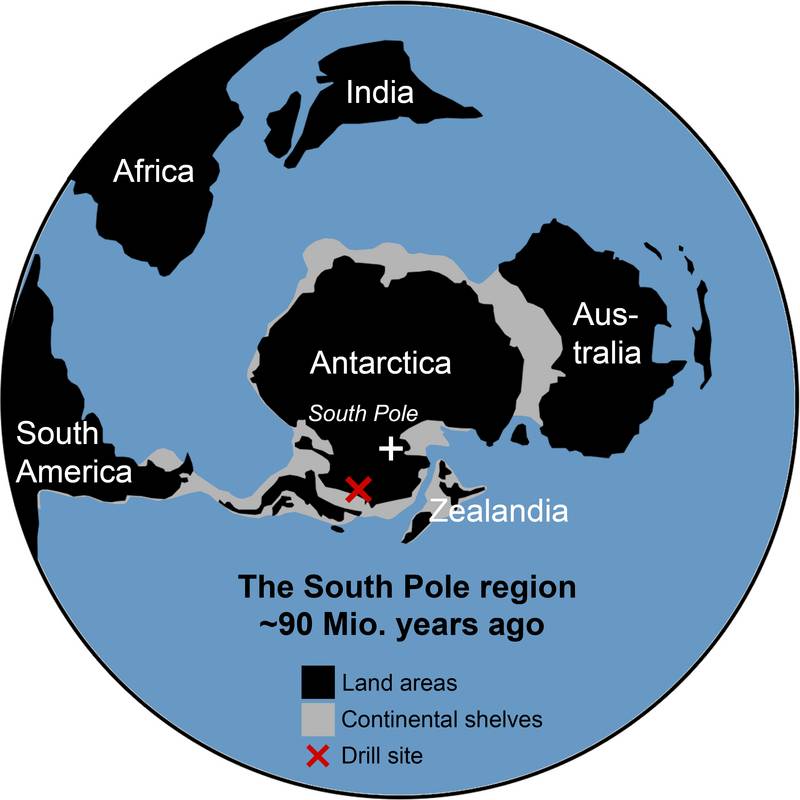科学家在南极发现了古代雨林的痕迹
科学家在南极发现了古代雨林的痕迹
Since time immemorial, Earth's poles have resembled frozen wastelands. Life can and does exist there, but there are sound reasons why humans and most other animals cling to the safety of more hospitable climates closer to the equator.
自古以来,地球的两极就像冰冻的荒地。生命可以而且确实存在于那里,但人类和大多数其他动物之所以坚持在靠近赤道的更适宜气候的安全地带生存,有着充分的理由。
They were not always wastelands, though. We know that in our planet's ancient past, conditions were vastly different. In the mid-Cretaceous Period, about 90 million years ago, dense concentrations of atmospheric CO2 would have created much hotter global temperatures, melting polar ice sheets, and sending sea levels soaring to up to 170 metres (558 feet) higher than they are today.
不过,它们并不总是荒地。我们知道,在我们星球的远古历史中,情况大不相同。在大约9000万年前的白垩纪中期,大气中高浓度的二氧化碳会造成更高的全球温度,极地冰原融化,海平面比现在高出170米(558英尺)。
What would the South Pole have looked like in a world like that? Thanks to a stunning scientific discovery, we have our answer.
在那样的世界里,南极会是什么样子?多亏了一项惊人的科学发现,我们有了答案。
In 2017, during an expedition aboard the RV Polarstern in the Amundsen Sea, researchers drilled deep into the ground underneath the seabed of West Antarctica, close to the location of the Pine Island and Thwaites glaciers, and only about 900 kilometres (560 miles) away from the South Pole.
2017年,在阿蒙森海(Amundsen Sea),研究人员乘坐RV极地号(RV Polarstern)进行考察时,在南极洲西部海床下进行了深入的钻探,接近松岛(Pine Island)和斯维特(Thwaites)冰川的位置,距离南极只有约900公里(560英里)。

约9000万年前沉积时的南极地区简图
What they pulled up, particularly at depths of around 30 metres, starkly contrasted with the sediment composition resting closer to the surface.
他们打捞上来的东西,特别是在大约30米的深度,与靠近地表的沉积物成分形成鲜明对比。
"During the initial shipboard assessments, the unusual colouration of the sediment layer quickly caught our attention," says geologist Johann Klages from the Alfred Wegener Institute, Helmholtz Centre for Polar and Marine Research in Germany.
德国亥姆霍兹极地和海洋研究中心阿尔弗雷德·韦格纳研究所的地质学家约翰·克拉奇说:“在最初的船上评估中,沉积层的不同寻常的颜色很快引起了我们的注意。”
"The first analyses indicated that, at a depth of 27 to 30 metres (88 to 98 ft) below the ocean floor, we had found a layer originally formed on land, not in the ocean."
“最初的分析表明,在海底27至30米(88至98英尺)深处,我们发现了一层原本是在陆地上形成的,而不是在海洋里。”
They were in uncharted territory, in more ways than one. Nobody had ever pulled a Cretaceous Period sample out of the ground from such a southern point on the globe. Even so, the researchers can't have been prepared for what closer examination with X-ray computed tomography (CT) scans would reveal.
他们在很多方面都处于未知的领域。从来没有人从地球上这么南的地方从地下挖出白垩纪的样本。即便如此,研究人员还没有准备好接受x射线计算机断层扫描(CT)的进一步检查。
Back on land, scans described an intricate network of fossilised plant roots. Microscopic analyses also found evidence of pollen and spores, all pointing to the preserved remains of an ancient rainforest that existed in Antarctica approximately 90 million years ago, eons before the landscape was transformed into a barren province of ice.
在陆地上,扫描图描绘了一个复杂的植物根系化石网络。显微镜分析还发现了花粉和孢子的证据,所有这些都指向大约9000万年前存在于南极洲的古老雨林的遗迹,那是在南极洲变成一个贫瘠的冰原之前的亿万年。
"The numerous plant remains indicate that the coast of West Antarctica was, back then, a dense temperate, swampy forest, similar to the forests found in New Zealand today," says palaeoecologist Ulrich Salzmann from Northumbria University in the UK.
来自英国诺森比亚大学的古生态学家Ulrich Salzmann说:“大量的植物遗迹表明,在那时候,南极洲西部海岸是一片浓密的温带沼泽森林,类似于今天在新西兰发现的森林。”
- 频道推荐
- |
- 全站推荐
- 推荐下载
- 网站推荐


















